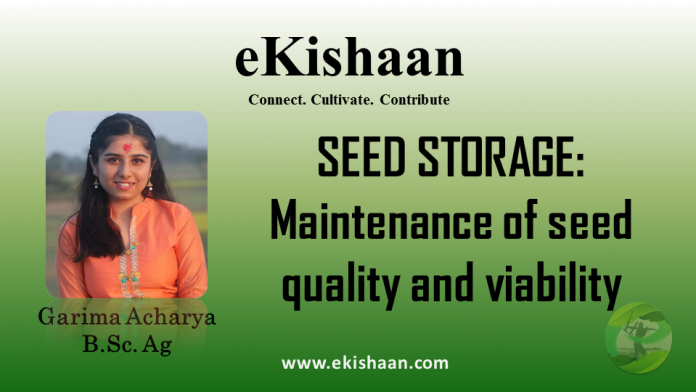SEED STORAGE: Maintenance of seed quality and viability
Seeds may not always be intended for use immediately after their harvest or collection, and often need to be stored for varying periods of time before their delivery to the restoration site or use in propagation programs. Since seed is a biological product, it deteriorates due to ageing during storage period. The process of ageing results in decline in quality and ultimately loss of viability. However, we can slow down this process of ageing of seed by proper storage conditions.
Seed viability means whether a seed is alive and could develop into plant under favorable field conditions whereas seed quality describes all potential performances of a seed lot. The purpose of proper seed storage is to keep the seed in good physiological and physical condition maintaining their viability and quality. Consequently, seed storage helps to minimize the incurrence of post harvest losses. When sourcing seeds for restoration, it is important that every single decision and step regarding the activities prior to storage (i.e. seed harvest and postharvest management) is taken considering best practices, to ensure that seeds of the highest possible quality enter the storage facilities. A proper care should begin from the field as deterioration of seed starts from physiological maturity. For harvesting activities, high quality seeds having maximum viability and optimal potential longevity can be achieved by collecting seeds at or close to the timing of natural seed dispersal. Seeds collected too early will be undeveloped and will lose viability when dried, or even fail to germinate altogether, whereas seeds collected too late may have reduced viability. For the production of quality seedlings, it is necessary to store large quantities of seeds for long periods of time. The ageing of seeds in storage leads to reduction in germination vigor as the seed metabolic system begins to break down, ultimately resulting in seeds being slow or even unable to germinate, and poor seedling development. Therefore a good seed storage mechanism is a basic requirement as it is key to maintaining seed viability and increase success in restoration activities. An effective seed storage relies on slowing down seeds’ normal metabolism as much as possible without causing much damage.
Seeds that are handled and stored improperly will have a shorter lifespan and the restoration will fail. Hence, management of effective storage conditions is important for maintaining seed quality and viability. A major means for such characteristic maintenance in the storage is decreasing the temperature and seed moisture content. In general, for each 1% decrease in seed moisture (when seed MC ranges between 5 and 14%) and for each 5°C decrease in storage temperature (between 0°C and 50°C), the life of seed is doubled. Rate of deterioration increases as the moisture content increases so it is necessary to dry seeds to safer moisture content. There is no insect activity at low seed moisture content ( below 8%), so the loss due to insects is minimized. If the seeds are not properly dried, the high moisture content may reduce the seed viability by promoting fungal growth. Such deterioration could further result in decline of seed germination capacity. Normally, for the major cereal crops, a moisture content of 10% is satisfactory for a storage period of 12 – 18 months. At this condition, seeds respire at normal rate and maintain their vigor and viability. A properly managed storage for seeds should not exceed 60% in relative humidity. The storage should be clean and disinfected before seeds are kept. There should be the periodical supervision of the seed lot. Direct sunlight on seed is harmful for viability. So the storage of seed should be done in cool, well ventilated go- down or moisture proof container.
Good seed storage management practices after harvesting is of prime importance, especially for seed production programs or restoration practitioners. It is a must, as it helps for maintenance of seed quality and viability. We should always remember that seed quality is not improved in the storage; it is just maintained at its best. So the standard practices must be followed starting from seed collection and during postharvest seed management, prior to seed storage in order to ensure that a seed lot of good quality (i.e. high seed viability) reaches the storage facilities. After seed collection and before seed storage, seeds should be dried to appropriate levels of moisture content and relative humidity and packaged for storage in an appropriate airtight container.

